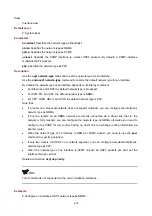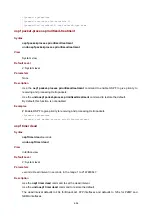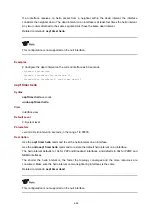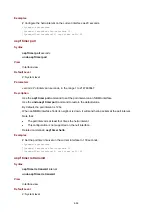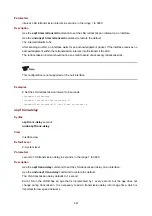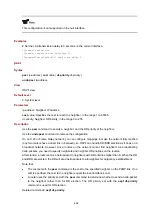
4-67
hello
seconds
: Hello interval in seconds, in the range 1 to 8192. The default is 10. It must be identical
to the hello interval on its virtual link neighbor.
retransmit seconds
: Retransmission interval in seconds, in the range 1 to 3600, which defaults to 5.
trans-delay seconds
: Transmission delay interval in seconds, in the range 1 to 3600, which defaults
to 1.
dead
seconds
: Dead interval in seconds, in the range 1 to 32768, which defaults to 40 and is identical
to the value on its virtual link neighbor. The dead interval is at least four times the hello interval.
md5
: MD5 authentication.
hmac-md5
: HMAC-MD5 authentication.
simple
: Simple authentication.
key-id
: Key ID for MD5 or HMAC-MD5 authentication, in the range 1 to 255.
plain
|
cipher
: Plain or cipher type. If plain is specified, only plain password is supported and
displayed upon displaying the configuration file. If cipher is specified, both plain and cipher are
supported, but only cipher password is displayed when displaying the configuration file. By default,
MD5 and HMAC-MD5 support cipher password, and simple authentication supports plain password.
password
: Plain or cipher password. Simple authentication: For plain type, a plain password is a string
of up to 8 characters. For cipher type, a plain password is a string of up to 8 characters, and a cipher
password is a string of up to 24 characters. MD5/HMAC-MD5 authentication: For plain type, a plain
password is a string of up to 16 characters. For cipher type, a plain password is a string of up to 16
characters, and a cipher password is a string of up to 24 characters.
Description
Use the
vlink-peer
command to configure a virtual link.
Use the
undo vlink-peer
command to remove a virtual link.
As defined in RFC 2328, all non-backbone areas must maintain connectivity to the backbone. You can
use the
vlink-peer
command to configure a virtual link to connect an area to the backbone.
Considerations on parameters:
z
The smaller the hello interval is, the faster the network converges and the more network
resources are consumed.
z
A so small retransmission interval will lead to unnecessary retransmissions. A big value is
appropriate for a low speed link.
z
You need to specify an appropriate transmission delay with the
trans-delay
keyword.
The authentication mode at the non-backbone virtual link end follows the one at the backbone virtual
link end. The two authentication modes (MD5 or Simple) are independent, and you can specify neither
of them.
Related commands:
authentication-mode
,
display ospf
.
Examples
# Configure a virtual link to the neighbor with router ID 1.1.1.1.
<Sysname> system-view
[Sysname] ospf 100
[Sysname-ospf-100] area 2
[Sysname-ospf-100-area-0.0.0.2] vlink-peer 1.1.1.1

